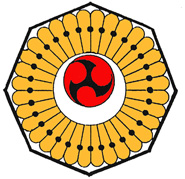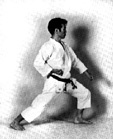Shindo Ryu Karate Kata - Kyu Ranks

Welcome to the Shindo Ryu Karate Kyu Kata Page. Following will the required kata for each student karate rank below Black Belt and then a brief explanation of the form.
Taikyoku Shodan, Nidan & Sandan 10th & 9th Kyu

(First movement of Taikyoku Shodan. Demonstrated by Master Oshima from Gichin Funakoshi's "Karate Do Kyohan")
The Taikyoku series were developed by Gichin Funakoshi.Taikyoku means "First Cause". They were called this to emphasize the importance of the first things a student learned....the BASICS or Kihon. Like ALL traditional karate kata the Taikyokus begin with a block. This demonstrates that karate is an art of self defense, in other words I must first be attacked before I will use my karate. The Japanese say "Karate Ni Sente Nashi", "There is no first attack in Karate". Basic to the eye these forms are the foundation on which the karate house is built.
Pinan Shodan, Nidan, Sandan, Yondan & Godan
8th, 7th, 6th, 5th, 4th Kyu
Pinan means "Peace & Harmony" or "Peaceful Mind". The Japanese call these forms Heian. They were developed by the great Shuri Te master Anko Itosu. Some historians believe that one of Itosu's students, a master in his own right, Gichin Funakoshi helped in their development. But true to the Okinawan culture, if Funakoshi did help he certainly did not accept any of the credit. Itosu developed these forms for school children. He found that kids could benefit greatly from karate but had to break it down into a simpler form. With school kids moving to new schools and grades each semester or year, Itosu knew the old style of teaching kata,"Hito Kata Sanen" or "One Kata for Three Years", was not practical. There is some debate over which kata influenced the Pinans the most. It is widely accepted that the forms Kusanku (Kanku Dai) & Channan were the true source. Kusanku is still widely practiced but Channan has been lost to history.
Saiha (fa) 3rd Kyu
Saiha, sometimes called Saifa, translates as "Rolling Wave" or "To Break or Smash". This form was either brought from or influenced by the Chinese martial arts, namely the white crane systems. Saiha originates in the Okinawan city of Naha and is practiced by the Shindo, Goju and Kyokushin schools. This kata has many angled steps and movements to parry an attacker. Also included are one legged crane stances. An advanced form taught to brown belts.
Bassai Dai 2nd Kyu
Bassai means "To Penetrate a Fortress". Dai means "Major", "Big" or "Primary". The Bassai Dai kata also known in Okinawa as Passai Dai is the original version of the form. Other variations are known as Bassai Sho, Ni & San. Bassai is a very strong kata. It incorporates heavy multi-block combinations to wear down and destroy an attackers offense and defense. Originally practiced in Shuri Okinawa, there is also a version that likely had roots in the Tomari village.
Hangetsu 1st Kyu
Hangetsu means "Half or Crescent Moon". The name describes the way the karateka (practitioner) steps in arc patterns. Known in Okinawa as Seisan its name was changed by Gichin Funakoshi after he introduced karate to mainland Japan.
"Kata equals Kumite, but Kumite can never equal Kata."
 Back to Main Page
Back to Main Page
 Yudansha Kata
Yudansha Kata
 Kobudo (weapons)
Kobudo (weapons)
 Promotions, Competitions & News
Promotions, Competitions & News
 Associations
Associations
 About Renshi A. Blackburn
About Renshi A. Blackburn
 A. Blackburn Traditional Karate Dojo
A. Blackburn Traditional Karate Dojo
 Sensei's Thoughts (Movie & Book review and more)
Sensei's Thoughts (Movie & Book review and more)
 Our Links Page
Our Links Page
 Goshin Budo Jiujitsu
Goshin Budo Jiujitsu
 Traditional Karate Association Homepage
Traditional Karate Association Homepage
Email: shindo@citrus.infi.net












